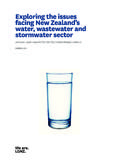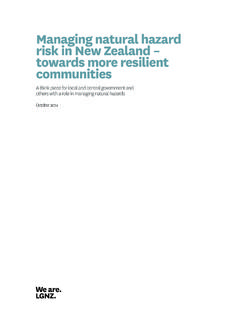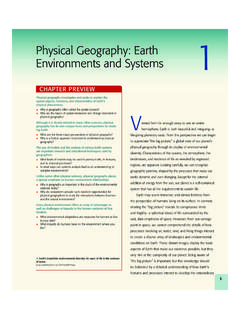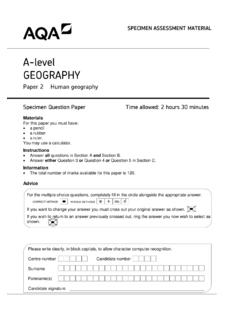Transcription of Local Government New Zealand Regional Sector Water …
1 Local Government New Zealand Regional Sector Water Subgroup Initial Economic Advisory Report on the Essential Freshwater Package Cover photo: Looking westwards to Otautau with the Aparima River in the foreground. Source: Emma Moran Acknowledgements This report has been compiled with the help and support of many people from different regions. Our thanks must go to Nicky Smith (Market Economics), Sandra Barns, Nicola Green and Santiago Bermeo (all from Bay of Plenty Regional Council), Femi Olubode and Mike Scarsbrook (both from Waikato Regional Council), Christina Robb (Happen Consulting Ltd.), Clare Wooding (LGNZ), Karl Erikson, Ewen Rodway, Vicky Collard, and Denise McKay (all from Environment Southland). Everyone involved has worked hard to supply sufficient and accurate information for inclusion in this report within a very tight timeframe and limited context.
2 Any errors and important omissions in the report should be considered with this in mind. This report was produced for the LGNZ Regional Sector Water Subgroup by Emma Moran (Environment Southland) and Blair Keenan (Waikato Regional Council). The purpose of this report was to give initial economic advice on specific draft proposals in the Government 's Essential Freshwater Package (working draft as it was at 21 June 2019) to inform discussions between the Regional Sector and the Ministry for the Environment. The Ministry for the Environment has refined the Package since this date but the specific proposals considered here have remained largely unchanged. Consequently, this report's findings are broadly applicable to the final proposals in the Essential Freshwater Package as released on 5 September for public consultation. The initial economic advice is currently being developed further to develop Local governement's understanding and inform their submissions.
3 For clarity, this report is not intended to be a policy document. Version Final Date 25 July 2019. 2. Executive Summary The Essential Freshwater Package aims to do more to protect and restore the ecosystem health of waterbodies, and to do it more quickly, than is currently occurring. If successful then it is reasonable to expect that these reforms will avoid some of the longer term costs from the effects of human activities on fresh Water , particularly with the impending threat of climate change. It is also reasonable to expect that the reforms will increase the short to medium term financial costs to those activities as they adjust to the new policy direction. The costs and benefits will ultimately flow through to the wellbeing of communities across New Zealand . The purpose of Local Government is to meet the current and future needs of Local communities, which includes maintaining and restoring healthy ecosystems.
4 This report is an initial assessment of the shorter term financial costs to some regions of specific proposals in the Essential Freshwater Package. Its purpose is to provide a preliminary understanding of these impacts to the Regional Sector . The report focuses on the following draft proposals: A National Environmental Standard for Freshwater Management (NESFM) and section 360. regulations, including farm environment plans, stock exclusion, and a cap on nitrogen loss for some Water bodies; and The inclusion of attribute tables in the National Policy Statement for Freshwater Managrment for Dissolved Inorganic Nitrogen (DIN) and Dissolved Reactive Phosphorus (DRP), especially in relation to national bottom lines for nutrients in rivers. These elements were identified by the Regional Sector Water Subgroup (RSWS) as priorities. Analysis of other proposals may be included in the next phase.
5 While the DIN and DRP proposal should also apply to urban activities, they are not considered in this report because it has been prepared ahead of pending changes to wastewater and stormwater management as a result of the Three Waters Review. A more complete economic evaluation is planned for the coming months. This work sits alongside other work considering the implications for Regional councils of implementing the Essential Freshwater Package. The basic approach taken here to assess the shorter term financial costs at a Regional scale is to consider two basic questions: 1. What are the costs of changing the current direction of New Zealand 's freshwater management policy? 2. What are the costs of changing the current timeframes for New Zealand 's freshwater management policy? There is considerable variation between and within Regional New Zealand that will influence the costs of any national direction.
6 This assessment has been delivered within a short timeframe and looks at specific regions but this picture will be quite different in other regions. The authors note that where an economic activity's use of Water (either as a Water take or to receive pollutants) is not accounted for in its production system, and this use impacts on other values, then all of the community is, in effect, subsidising that activity. This is the case regardless of the economic Sector being considered ( agriculture, forestry, manufacturing, tourism, Local and central Government ). 3. Main findings The nature and extent of the full economic impacts of the Essential Freshwater Package (working draft) will depend on how people can and do respond to change. People's incentives are influenced not just by financial considerations but also other factors, including their level of engagement in, and understanding of, an issue.
7 Farms are not only businesses; they are also family homes and, in some cases, have been so for many generations. With these points in mind, the main findings of this report are: 1. Proposed DIN and DRP attribute tables The use of national averages, without recognising the inherent complexity of natural systems, will likely impose unnecessary, and potentially very large, financial costs in many locations. Regulations based on these averages are likely to fail the cost-effectiveness and efficiency tests for policy because statistical evidence indicates nutrients only explain a small amount of the variation in ecological health of Water bodies. When implemented, the financial costs may be significant in some localities, but the costs will depend on the targets that are set ( limits and timeframes) and the spatial scale of any management approach. In other cases the costs will be more muted at a Regional or national scale.
8 2. Waikato case study Scenario 1 (no land use change) The DIN and DRP proposals were tested for the Waikato-Waipa catchment (pre-Plan Change 1) because of their particular relevance to soft-bottomed rivers and streams. There was also a pre-existing economic model developed for the Healthy Rivers/Wai Ora Plan Change 1 process. The impacts from these proposals can also be expected in many other catchments where soft-bottom streams are prevalent, such as the Bay of Plenty and Northland. The modelling for the Waikato-Waipa catchment was designed to find the least cost solution ( a set of possible actions that fit the policy) but initial work, with land use held as fixed, showed the scenario may not have a feasible solution. Further analysis of this finding is recommended. 3. Waikato case study Scenario 2 (with land use change) When the economic model allowed land use to change ( it was not fixed), a least cost solution was found that involved large- scale afforestation.
9 In the model's solution, drystock farming in the catchment contracts markedly, dairy and dairy support also contracts but to a lesser extent, while forestry increases to more than half of the catchment. The shift away from drystock land in this solution occurs because it is less profitable than dairy, so results in a lower opportunity cost when it converts to another land use. The model estimates an annualised cost of the DIN and DRP proposals for the Waikato-Waipa catchments of around $100 million (or 11% of the total profits from land use each year). In reality, there will be other solutions and their impacts will depend on the allocation method and mitigations available, in addition to the targets and spatial scale for management highlighted above. 4. Farm environment plans The Farm Environment Plan proposal generally aligns with the policy direction of many regions but not all.
10 Their fast-tracking across New Zealand will substantially increase the skilled labour and financial capital needed. This circumstance is particularly relevant in regions where farm environment plans are not currently required such as in most of the Bay of Plenty. Improving the delivery of the farm environment plans required by Regional councils will flow through to an uptake by farmers of mitigations and result in behavioural change it will do more to improve Water quality, more quickly. 4. 5. Southland case study (farm environment plans) A scenario similar to the farm environment plan proposal was modelled for Southland that assumed the region was at the start of the process ( no existing plans). Although there are large gains to service industries, it was estimated that the accumulated change in value added by 2030 for Southland's economy is around -$17 million.







